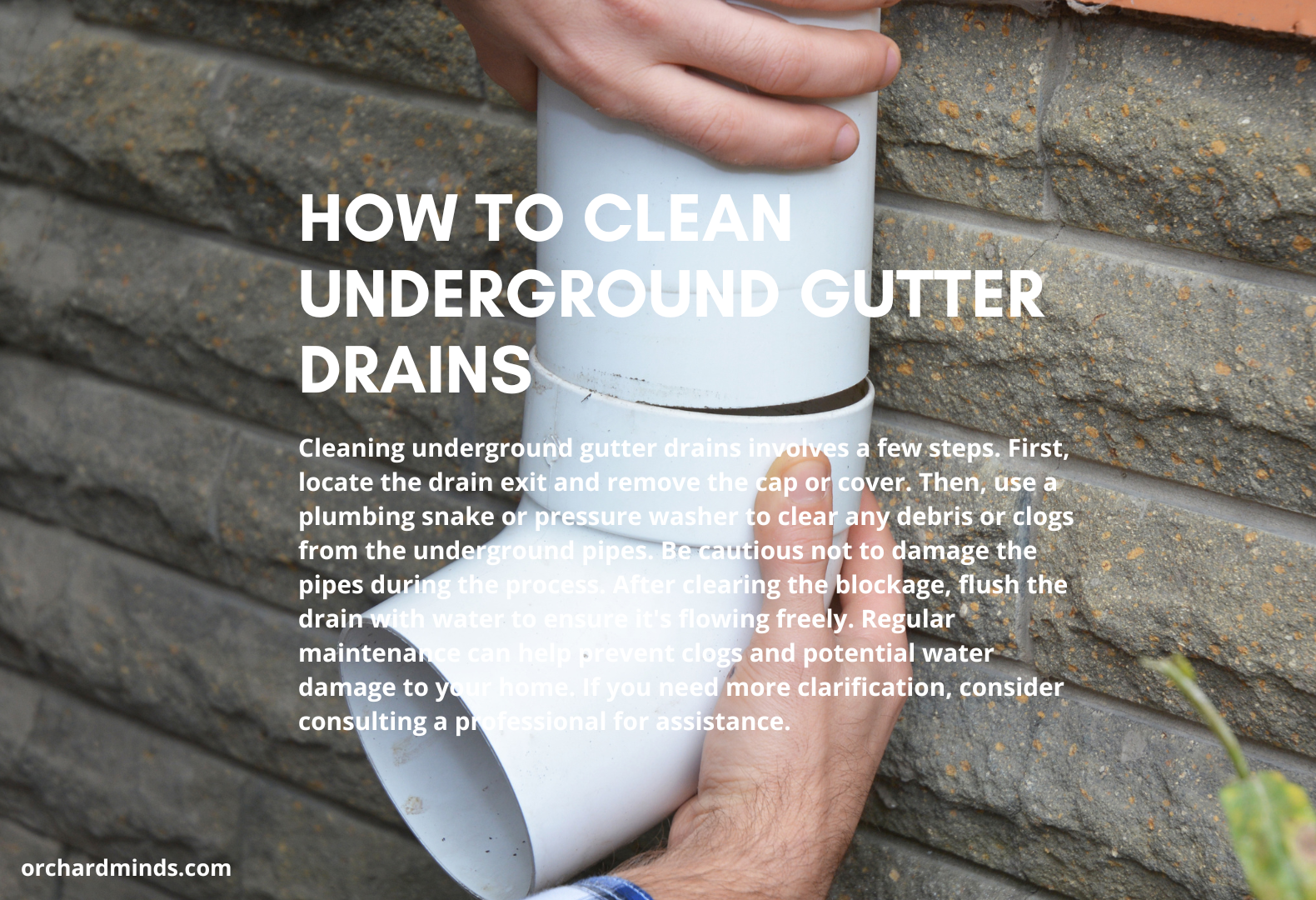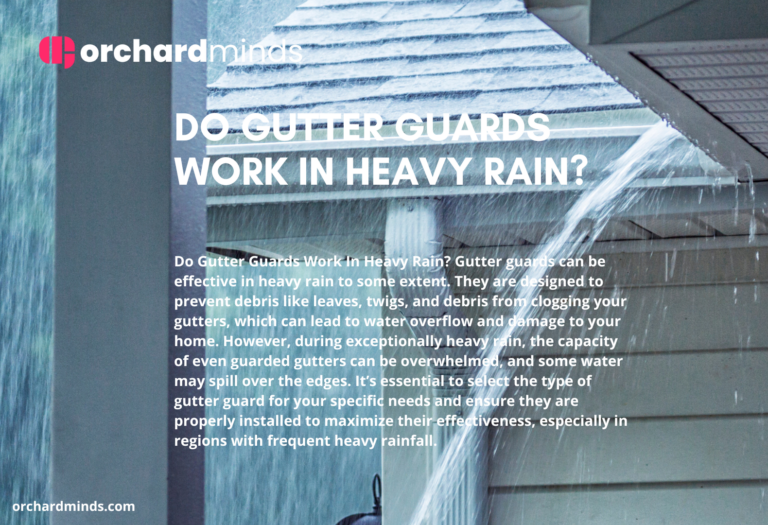Cleaning gutter drainage can be done in a few steps. One has to locate the exit of the drain and uncovers the cap or cover of the same. Then, one can use a plumbing snake or a pressure washer to clear debris and clogs of underground pipes. Caution should always be taken during the clearing process so as not to damage the pipes. Where a blockage has been cleared, the drains should be flushed with water to double-check freedom of movement. Regular maintenance may save you from clogs and potential water damage at home. If you are not familiar with the process, a professional could help you do it.
Unclog Your Underground Downspout Drainage System
To unclog the underground downspout drainage, locate the point of discharge and unscrew the cap. Insert a plumber’s snake or high-pressure water jet to break and flush the clog in the pipes:.
Be gentle to avoid damaging the pipes. Once the clog is cleared, flush the system with water to ensure proper drainage. Regular maintenance and keeping debris away from the downspouts can help prevent future clogs. If you’re unsure about the process, consider seeking professional assistance.
Locate the Clog
To locate the clog in your underground downspout drainage system, look for where water is pooling or has stopped draining properly.
Trace the path of the underground drainpipes to see if there are signs of blockage, like wet or muddy parts and water that spills out in places that are not supposed to be the exit point. It is recommended to gently probe the ground with a long stick or rod to establish the exact location of the blockage. Carry out the process of unclogging as earlier detailed after the clog’s location has been established.
How to Unclog Underground Drain
Unclogging an underground drain begins with locating the point where the clog is. Actually, the position of a clog is typically detected by the existence of poor drainage or standing water. All one has to do, after having located effectively the clog, is to carefully take out the covering or cap on top of the drain and apply more pressure using a plumbing snake or a high-pressure water jet to destroy and push the materials clogging out of the drain-system pipe, without necessarily using too much pressure to cause breakage onto the pipes first-hand. Flush the drain with water after you have freed it. This way, the flow of the drainage is fully cleared. Regular maintenance, where you take steps to avoid debris from going into the drain system, will keep off future clog problems.
Can Gutters Get Clogged and Create Roof Damage?
It is indeed true that clogged gutters can lead to roof damage. Things such as leaves, twigs, and dirt clog the gutters, and this denies them the ability to effectively drain rainwater off the roof area. The net effect is flooding water at the edges of the roof before it seeps under your shingles to cause roof leaks, water damage, and structural issues over time. Regular gutter maintenance is an important step in preventing these kinds of problems and ways through which the integrity of your roof may be compromised.
What Items Besides Leaves Can Clog a Gutter?
Besides leaves, there are several other elements that can clog a gutter:
Pine Needles : Pine needles usually cause the most common blockages, especially in pine tree environments. In most cases, pine needles intertwine with each other, hence, blocking the gutters.
Granule Loss: Over time, asphalt shingle roofs can lose the granules that collect in gutters. Granules left backed up cause the rest of the headings.
Bird Nests: Birds can have nests either in or near the gutters, an occurrence that blocks the water flow or hinders it. There is, therefore, a need to look for birds’ nests and thereby remove them, an activity that falls under the maintenance bracket of gutters.
Bindweeds: These weeds are easy to grow and spread all over the garden quickly. They tend to make the gutters their pathways. Also, they easily find their way into the unclogged gutters. Dirt and Debris: Windblown dirt, dust, and small debris can also find their way into gutters and possibly cause blockages when left unattended. To prevent this, perform regular cleanup of gutters and install gutter guards.
Insect and Pest Debris: Insects can nest in gutters and therefore make their nests there, leaving some droppings. This clogs those gutters and attracts other unwanted pests attracted to the decaying matter.
Keeping your gutters clean and having efficient gutter guards installed will help to prevent the accumulation of these various forms of debris, resulting in blockages and potential damage to your home.
What if I Can’t Fix My Clogged Underground Drain?
If you find that the underground drain is blocked and you can’t clear it yourself, then you would be better advised to call in the experts. A bad, or lasting, one probably indicates further underlying issues in your drain system now requiring professional handling to solve and correct. A professional plumber or specialist in draining uses special equipment and techniques, such as drain cameras and high-pressure water jets, to locate and remove the blockage. They can also inspect and check the condition of your underground pipes, giving advice on the need for repairs or replacements if they find a damaged section. You should not be ignoring even the smallest problem with it because a blocked underground drain can eventually cause water damage, foundation problems, or even loss of the structure. This will be ensured when seeking professional help such that any problem can be rectified correctly to prevent further complications that can even lead to your property not being maintained.
What Are the Best Alternatives to Gutters
While gutters may be the most common solution for rainwater running off your roof, there are some alternatives you should consider if you really don’t want to install gutters. One example is a decorative rain chain — far nicer than a downspout — where the rainwater passes into a chain or some sort of cup and splashes into a collection basin, or onto decorative stones, or a garden. What can also be done is a French drain, with a length of perforated pipe buried in the ground around your house, collecting the rainwater that seeps into it and then whisking it away from your foundation. Rainwater may be channeled into rain gardens at strategic points, thus reducing the risk of erosion through plant life and percolating the water into the soil. Another idea is sloping the landscape down from the foundation of your home, which by its very nature slopes the rainwater away from your property. Local climate, your desired aesthetics, and the layout of your property will ultimately determine the best way forward, but proper drainage and elimination of water problems can still be achieved without ordinary gutters.
How Wind Damage Can Affect Your Roof and Gutters
Wind can also do much damage to your roof and gutters. Powerful gusts may lift and rip off the shingles; continuous battering from them can lead to future probable leaks and water infiltrations. If serious enough, it could tear off big portions of it. Moreover, wind-borne material like branches or any other kind of object may hit the gutters, which may then cause dents,misalignment, or detachment.
Gutters fill up with wind-borne material and hamper draining. Periodically look over your roof to repair it in time and avert further water or structural damage to your home from damage by winds.
FAQs
Why do I need to clean underground gutter drains?
Cleaning underground gutter drains is necessary for preventing blockages, particularly those causing water damage like flooding, foundation problems, and landscape erosion.
How does one know if an underground gutter drain is clogged?
The telltale signs of a blockage are poor drainage, water collecting at the foundation of your home, or spilling out all along specific areas in the drain route.
Will a regular drain cleaner be enough to work on underground gutter drains?
No, normal cleaners should not be used. You will want either a plumbing snake or a high-pressure water jet for this task.
How often should I clean my underground gutter drains?
The frequency of cleaning is primarily decided based on the local climate and how much junk might be lying around in your area. In a rough estimate, though, they should at least be checked and cleaned once or twice a year.
Is it possible for one to clean underground gutter drains independently, or should this be contracted to a professional?
Yes, you can do them by yourself but caution and the right tools are required. If unsure or problems arise, then seek help with professionals.
Are there any preventative measures one could implement to reduce cleaning frequency?
Cleaning the gutters, installing gutter guards, and making sure proper ground slope away from your home will all help reduce the frequency of underground drain cleaning.
What do I do when I cannot find or clear a blockage in an underground gutter drain?
If you are not able to clear the clog or if you just can’t seem to find it, then contacting a professional plumber or drainage consultant may be in your best interest for finding this issue and resolving it.




Leave a Comment